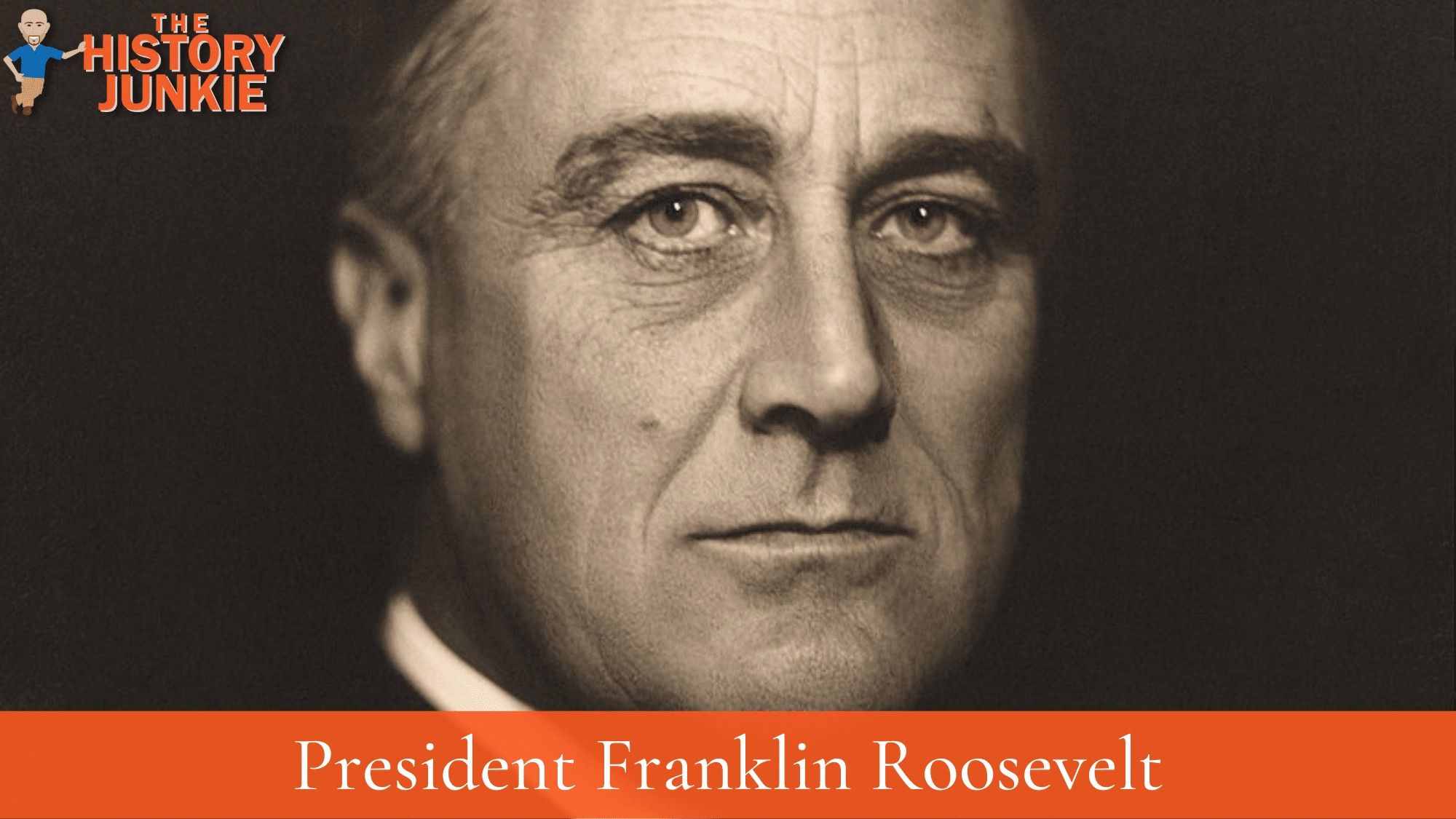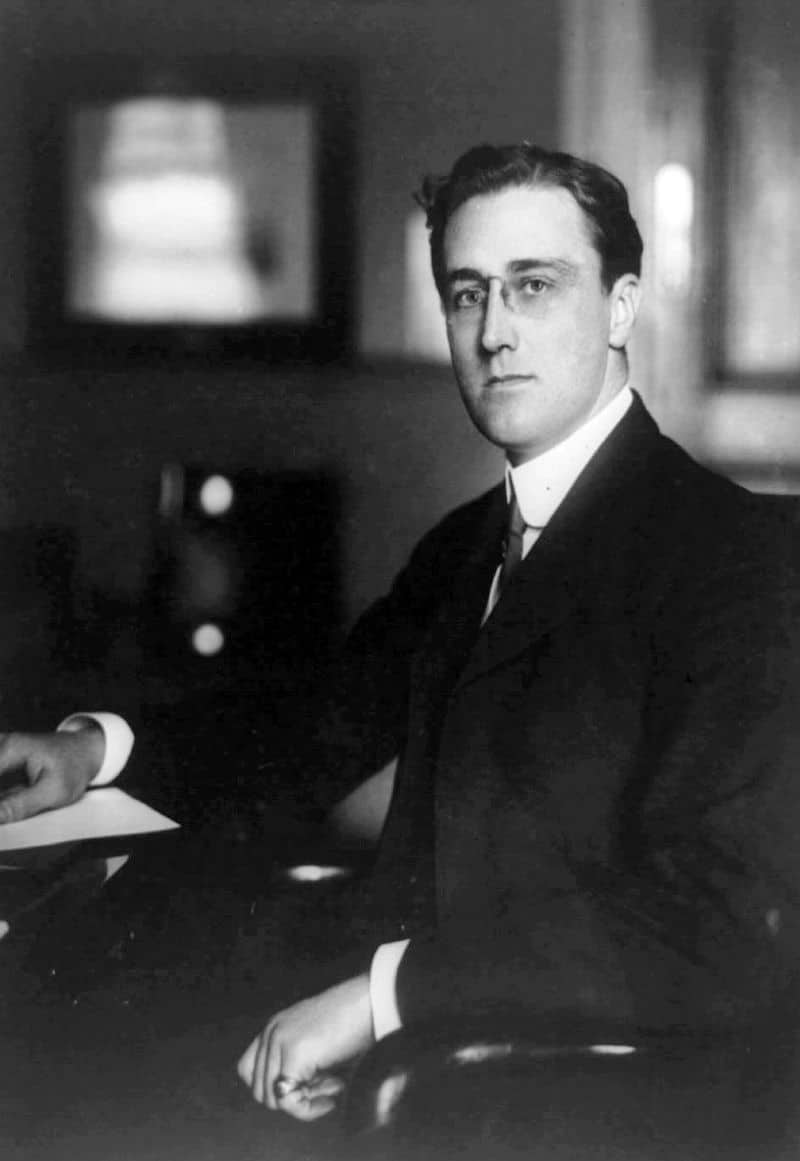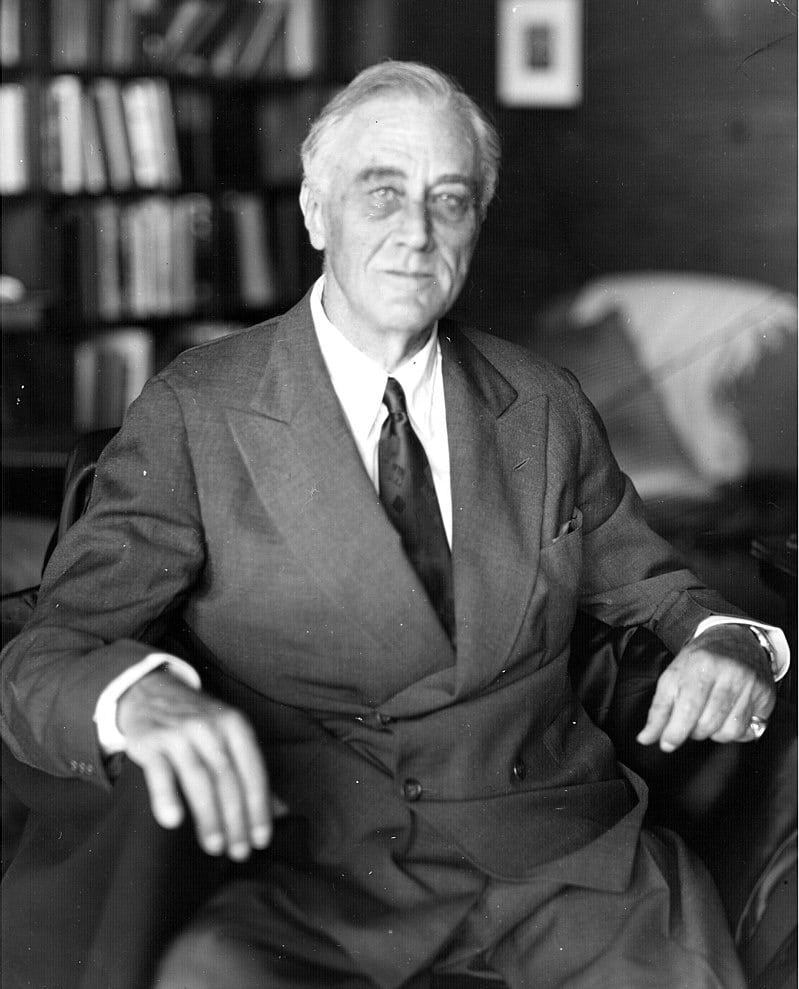President Franklin Roosevelt came into the presidency during a dire time in the United States. The Great Depression had become a global issue, and many Americans were struggling to find work and put food on their table.

It was a hard time for many throughout the country, but unlike President Herbert Hoover before him, Roosevelt offered a solution with what he called the New Deal.
The New Deal would enlarge the government more than ever before, and while many critics have said that FDR overreached, most Americans at the time wanted some sort of relief and hope.
FDR's presidency would span over 12 years and would lead the country through the Great Depression and World War 2.
Jump to:
President Franklin Roosevelt's First Term

March 4, 1933: Franklin Roosevelt was inaugurated as the 32nd President of the United States.
March 5, 1933: After one day in office, FDR orders a Bank Holiday. This would halt the run on the banks that were causing many to fail.
March 9, 1933: With FDR's influence, Congress passed the Emergency Banking Act. This forces every bank to prove they are solvent before reopening after the bank holiday.
March 12, 1933: Franklin Roosevelt delivers the first of many "Fireside Chats" via the radio. These radio addresses would provide much comfort to the nation and increase his popularity and trust.
March 31, 1933: Congress creates the Civilian Conservation Corps. It immediately put 250,000 young men to work, and by the time the program ended, it had provided 2,000,000 jobs.
April 19, 1933: Roosevelt takes the United States off the gold standard. This was very controversial at the time. However, his actions were made to try and stimulate the economy by allowing more money in circulation.
May 12, 1933: Congress passed the Federal Emergency Relief Act to provide grants to states rather than loans. This would allow states to provide relief to those inside their borders. Congress also passed the Agricultural Adjustment Act, which would restrict the production of some agricultural goods in hopes to drive prices up and aiding farmers that were suffering.
May 27, 1933: Congress passes the Federal Securities Act, which requires all issued stocks and bonds to be registered and approved by the federal government.
June 16, 1933: A series of programs were launched to try and create jobs and stimulate the economy. The Public Works Administration was launched to provide construction of highways. The National Recovery Administration, Farm Credit Act, the Banking Act of 1933, and the establishment of the Federal Bank Deposit Insurance Corporation were also launched.
August 5, 1933: President Franklin Roosevelt created the National Labor Board to enforce labor's collective bargaining rights.
November 8, 1933: Harry Hopkins is appointed to lead the Civil Works Administration.
December 5, 1933: The 21st Amendment is repealed, and Prohibition is lifted.
February 2, 1934: The Export-Import Bank was established to try and increase foreign trade.
March 24, 1934: The Tydings-McDuffie Act sets a timetable for Philippine Independence.
April 12, 1934: The Nye Hearings are launched, and foreign policy in Europe is investigated.
May 10-11, 1934: A major drought caused the "Dust Bowl," which would devastate the Midwest.
June 6, 1934: The Securities Exchange Commission is created.
June 19, 1934: The Federal Communication Commission replaced the Federal Radio Commission created by President Calvin Coolidge. The FCC would expand regulation to the telephone, telegraph, and eventually television.
July 5, 1934: 7 workers die during their strike in Seattle, Washington. The event would be labeled Black Thursday.
November 6, 1934: The midterm elections take place, and Democrats increase their majority in both the House and Senate.
January 4, 1935: Roosevelt delivers his State of the Union address and talks about a Second New Deal that would target the elderly, unemployed, and others in need.
May 6, 1935: Roosevelt created the Works Progress Administration, which tried to create jobs for construction projects. The Republicans disagree and believe it to be a wasteful use of government resources.
May 11, 1935: The Rural Electrification Administration begins.
May 27, 1935: The Supreme Court finds the NIRA unconstitutional. This infuriates FDR.
July 5, 1935: FDR signed the National Labor Relations Act, which created the National Labor Relations Board. This ensures the right of labor unions to organize and bargain collectively.
August 14, 1935: The Social Security Act is signed.
August 30, 1935: Congress passes the Revenue Act.
August 31, 1935: FDR signs the Neutrality Act, which stops corporations from aiding those involved in warfare.
January 6, 1936: The Supreme Court declared the Agricultural Adjustment Act unconstitutional. They cite the reason being that the Federal Government does not have the power to do this since the power belongs to the states.
November 3, 1936: Franklin Roosevelt wins reelection in a landslide.
President Franklin Roosevelt's Second Term
January 20, 1937: FDR delivers his second inaugural address.
February 5, 1937: Roosevelt, angered over the Supreme Court's rulings on his New Deal programs, wants to add 6 more justices to pack the Supreme Court. This caused a sharp drop in his popularity as Republicans and Democrats opposed him.
March 1, 1937: U.S Steel agrees to recognize the United Steel Workers Union. This causes a domino effect for other steel companies.
May 1, 1937: FDR signs the Neutrality Act.
July 22, 1937: Congress created the Farm Securities Administration, which gives low-interest loans to farmers.
September 2, 1937: Congress passes the Natural Housing Act.
December 12, 1937: Japan attacks the US gunboat Panay. Japan apologizes and says it was a mistaken identity.
January 3, 1938: In his State of the Union address, FDR requested that Congress increase the military budget. Congress would agree.
February 16, 1938: FDR signs the second Agricultural Adjustment Act.
March 13, 1938: Austria is annexed by NAZI Germany.
May 26, 1938: The House of Un-American Activities Committee was founded to investigate all groups in the United States.
May 27, 1938: Congress overrides FDR's veto to pass a corporate income tax cut.
June 25, 1938: The Fair Labors Standard Act is passed. This raises the minimum wage and sets a 40-hour work week.
March 15, 1939: Germany invades Czechoslovakia and has control of the entire country within 2 weeks. This was due to the new tactic of Blitzkrieg that was implemented by Adolf Hitler.
April 7. 1939: The Spanish Civil War ends, and the dictator General Franco takes power.
August 23, 1939: Germany and the Soviet Union signed a Non-Aggression Pact.
September 1, 1939: Germany Invades Poland and conquers it in a week. The invasion begins World War 2.
September 3, 1939: France and England declare war on Germany.
October 18, 1939: The United States closes all ports to warring submarines.
November 4, 1939: President Franklin Roosevelt signed the Neutrality Act of 1939 with France and England.
November 30, 1939: The Soviet Union invades Finland. The Fins would put up an honorable fight but surrender to the Soviets the following March.
April 9, 1940: Hitler invades Norway and Denmark. Both fall.
May 10, 1940: Winston Churchill becomes Prime Minister of England.
May 26 - June 4, 1940: The French and British evacuated from the coastal town of Dunkirk. Paris falls, but Allied forces survive to defend its home shores.
June-July 1940: Roosevelt is nominated for an unprecedented third term.
June 28, 1940: Congress passes the Alien Registration Act.
July 10, 1940: The Battle of Britain begins
September 16, 1940: Roosevelt signed the Selective Training and Service Act, which calls for a draft during peacetime.
November 5, 1940: Franklin Roosevelt is Re-elected for a third term.
President Franklin Roosevelt's Third Term
January 20, 1941: Franklin Roosevelt is inaugurated.
February 4, 1941: The USO is formed
March 11, 1941: FDR signs the Lend-Lease Act.
May 27, 1941: Hitler conquers Greece and Yugoslavia.
June 22, 1941: Germany invades the Soviet Union, which breaks the Non-Aggression Act they had signed prior.
June 25, 1941: FDR created the Fair Employment Practices Committee to fight discrimination in the workplace.
July 26, 1941: General Douglas MacArthur is appointed commander-in-chief of the U.S. forces in the Far East.
August 14, 1941: Roosevelt and Churchill meet in secret to issue the Atlantic Charter.
October 27, 1941: German U-boats attack the U.S. destroyer Kearney. Roosevelt does not declare war but does announce that America has been attacked.
October 30, 1941: 100 Americans die after a U-boat sinks the U.S. Destroyer Reuben.
December 7, 1941: The Japanese launched a surprise attack on Pearl Harbor, killing 2,400 Americans.
December 8, 1941: The United States declares war on Japan.
December 10, 1941: Japan invades the Philippines.
December 11. 1941: Germany and Italy declare war on the United States.
December 25, 1941: Japan captures Hong Kong
January 2, 1942: Japan captures Manila. This forced American troops to retreat to the Bataan Peninsula.
January 14, 1942: Roosevelt ordered all foreigners in the United States to register with the federal government.
February 20, 1942: Roosevelt orders Japanese-Americans to be forcibly removed from their homes to Internment Camps throughout the West.
March 11, 1942: General MacArthur is forced to leave the Philippines. He promises, "I shall return!"
April 9-10, 1942: Americans and Filipino soldiers captured on the Bataan Peninsula are sent on a 100-mile march that became known as the Bataan Death March.
April 18, 1942: The Americans launch a surprise bombing on Tokyo.
May 4-8, 1942: The Battle of the Coral Sea takes place. The Americans inflicted heavy casualties on the Japanese.
June 4-6, 1942: The United States wins the Battle of the Midway against the Japanese.
August 7, 1942: Marines land on Guadalcanal.
August 22, 1942: The Germans attack Stalingrad. The Soviet Union repels them but takes over 1,000,000 casualties.
January 14-24, 1943: The Allied forces meet at Casablanca, Morocco. During this meeting, it was decided that they would only accept unconditional surrender from the Axis Powers, invade Europe via Sicily and Italy, bomb Germany, and send aid to the Soviet Union.
March 2-4, 1943: The Battle of the Bismarck Sea was a major defeat for Japan that was dealt to them by the United States and Australians.
May 7, 1943: Britain captures the Tunisian city of Bizerte from the Germans. Likewise, the United States captured the capital, Tunis.
May 12, 1943: The Germans and Italians retreat from North Africa. The Allies gained control of the strategic Suez Canal.
May 16, 1943: The Warsaw Uprising is put down by the Germans. The Jews who participated were removed to concentration camps.
July 10, 1943: The Allies begin to attack Sicily and gain control of the island within 5 weeks.
July 19, 1943: The Allies bomb Rome. Benito Mussolini resigned, and by early September, Italy offered its unconditional surrender.
August 11-24, 1943: Meetings are held in Quebec, Canada, and Iran. It was decided that the Allies would attack the beaches of France to open up another front on Germany.
December 17, 1943: The Chinese Exclusion Act is repealed.
December 24, 1943: Dwight D. Eisenhower is named the Supreme Commander of the Allied Forces.
June 6, 1944: The D-Day invasion is launched. By its end, the Allies will have opened a new front on Germany.
June 13, 1944: Germany begins launching "Buzz Bombs" across the English Channel.
June 19-20, 1944: The Battle of the Philippine Sea is an American victory. The Americans destroyed over 400 Japanese planes.
June-July 1944: Despite his failing health and desire to retire, Roosevelt accepted a fourth nomination.
July 25, 1944: Operation Cobra was successful in cutting off German forces in Brittany, France.

August 21-October 7, 1944: The groundwork begins to be laid for what will become the United Nations.
November 7, 1944: Franklin Roosevelt is re-elected to a fourth term.
December 16, 1944: Germany launches a surprise attack on the Allies, which pushes the Allies back. The Allies regained their footing and counterattacked, successfully defeating Germany's last stand.
President Franklin Roosevelt's Fourth Term
February 4-11, 1945: Roosevelt, Churchill, and Stalin meet at the Yalta Conference.
February 4-24, 1945: U.S. Forces Recapture Manila
April 1 - June 21, 1945: U.S. Forces captured Okinawa in one of the bloodiest battles of the war.
April 5, 1945: The Soviet Union enters the war against Japan.
April 12, 1945: President Franklin Roosevelt suffers a massive cerebral hemorrhage and dies.
